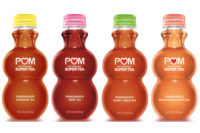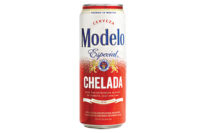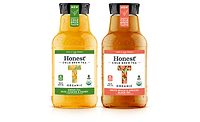When the cold and flu season strikes, a glass of orange juice is many consumers’ solution to getting their daily dose of vitamin C to help strengthen their immune systems. On average, 5 to 20 percent of the U.S. population, including normally healthy individuals, is affected by the flu each year, according to the U.S. Centers for Disease Control and Prevention. Although less severe than the flu, most adults also come down with the common cold two to four times a year, particularly from September through May, the American Lung Association says. And because there are no antiviral medicines for treating the common cold, many consumers turn to water and juices with minerals and vitamin C as at-home remedies, it notes.
Vitamin C happens to be one of the key antioxidant vitamins, along with vitamins A and E, according to Rockville, Md.-based Packaged Facts’ March 2012 report “Antioxidant Products in the US.” Antioxidants are molecules that inhibit the oxidation of other molecules, the market research firm states. In this way, antioxidants have the ability to neutralize free radicals, which have been shown to be harmful to the body’s cells, says Phil Kupper, senior scientist for Wild Flavors USA Inc., Erlanger, Ky. “Over time, free radicals can increase in the body and generate oxidative stress,” he says. “This gradual buildup of free radicals is thought to contribute to both the aging process as well as several disease states.”
Free radicals are molecules produced when the body breaks down food for energy or by environmental toxins, according to Chicago-based Mintel’s July 2012 report “Health and Wellness: Antioxidants have huge potential as functional food ingredients.” These molecules can damage cells and weaken the immune system, the market research firm reports. Free radicals also are believed to be linked to arthritis and cancer, among other diseases, it adds.
However, because endogenous antioxidants, or antioxidants produced by the body, are constantly being used by the body to curb oxidation and fight off free radicals, consumers must replenish their bodies’ antioxidant supplies on a regular basis, according to the Packaged Facts report. Therefore, consumers can benefit from a diet regularly filled with antioxidants, Wild Flavors’ Kupper adds.
Superfruit power
A variety of compounds can be used as antioxidant supplements, according to the Mintel report. The most common of these include beta-carotene, zinc, selenium and manganese, in addition to vitamins C and E, it states.
Common botanical and superfruit sources of antioxidants include green tea, blueberries, mangoes, raspberries, acai berries, pomegranates, red grapes, blackberries, lemons, oranges, tart cherries, plums, strawberries, spinach, kale and blue-green algae, says Randy Kreienbrink, director of marketing for BI Nutraceuticals, Long Beach, Calif.
However, the most popular sources of antioxidants tend to change over time as market trends evolve, notes Cal Bewicke, president of Ethical Naturals Inc., San Anselmo, Calif. For example, maqui berry is a popular antioxidant source this year, say Jamie Goodner, principal scientist, and Paula Morrison, key account technical director, of Wild Flavors. Maqui is an evergreen shrub found in Chile and Argentina, according to WebMD. The plant’s superfruit berries and juices contain anthocyanins, which offer high levels of antioxidants, and are commonly used to aid weight loss, detoxification and general health and wellness as well as to reduce the risk of inflammation, diabetes and heart disease, it says.
Blueberries, another superfruit, also have been linked to heart health, anti-aging properties, cancer prevention, improved eyesight and better memory because of their high antioxidant property, says Tom Payne, industry specialist for the U.S. Highbush Blueberry Council, Folsom, Calif. “Studies of older laboratory animals consuming blueberry-supplemented diets have shown measurable improvements in memory, coordination and balance,” he says. “Research is also uncovering neuron regeneration in older animals fed blueberries.”
Similarly, research by Tufts University, Medford, Mass., has shown that consumption of the superfruit acai improves working and reference memory in older rats. This study, which was supported by the U.S. Department of Agriculture, Washington, D.C., and the American Institute for Biosocial and Medical Research (AIBMR) Life Sciences Inc., Puyallup, Wash., found that rats on an acai diet were able to improve how fast they completed a maze over two days of trials, while control rats that did not consume acai did not show any improvement during the trial period.
In addition to health benefits, choosing to include antioxidant ingredients like superfruits in a beverage offers consumers a taste of the familiar, says Kevin Holland, product developer for Tree Top Inc., Selah, Wash. “For everyday … occasions, [consumers] will gravitate toward fruits from their homeland, whether that be cherries or mangoes,” he says. Several U.S. fruits, including cherries, blackberries, apples and grapes, fall into the category by offering a familiar source of antioxidants, he says.
In line with this, Ethical Naturals offers VinCare, a grape extract antioxidant ingredient that works well in beverages, Bewicke says. The highly concentrated whole grape extract is standardized to contain 80 percent polyphenols and to have an oxygen radical absorbance capacity (ORAC) value of 15,000 units in each gram, according to the company. VinCare also offers high solubility and a low taste profile, making it ideal for use in nutritional beverages, Bewicke adds.
Using superfruits as the antioxidant source also makes marketing the product even easier, the U.S. Highbush Blueberry Council’s Payne says. “Beverage formulators know they can put blueberries on the label and take advantage of the image of blueberries as a healthy, delicious fruit full of natural goodness and enhancing the positive associations of comfort food,” he explains. This wholesome image of the natural benefits of superfruits attracts consumers seeking a burst of healthfulness in their everyday diets, he says.
Stealing the spotlight
The overall benefits of antioxidants are becoming common knowledge among consumers. In fact, only 8 percent of consumers are unaware of what antioxidants are, Mintel reports. Plus, interest in food and beverage products with antioxidants spans multiple generations, experts note. Seniors, baby boomers and members of Generation X all desire healthy, nutritional products to keep them active, fit, energized and happy, BI Nutraceuticals’ Kreienbrink says.
Drinks traditionally have been the main delivery vehicle for antioxidants, Mintel reports. In fact, beverages account for seven of the Top 10 categories featuring antioxidant claims, it states. Additionally, food and drink products featuring antioxidant claims have been on the rise in the last decade, it reports. In 2013, more than 1,000 new beverages featuring antioxidants were launched, compared with 765 in 2012, according to the Mintel Global New Products Database.
Demand for antioxidant-infused beverages is coming directly from consumers, Mintel notes. In fact, half of U.S. functional drink buyers look for antioxidants in the beverages they buy, the market research firm reports. This interest in antioxidants is much higher than it is for any other functional ingredient in the drinks, it states.
Ingredient suppliers also are noticing the increased interest in antioxidants. Ethical Naturals’ Bewicke notes that approximately 25-30 percent of his customer requests are for antioxidant ingredients. Similarly, BI Nutraceuticals’ Kreienbrink reports that antioxidants are one of the Top 3 functional ingredient requests for the company.
Tea time
Much of the new product development surrounding antioxidant ingredients is dominated by bagged and loose-leaf tea, which accounted for 13 percent of the antioxidant claims in global food and beverage launches in 2012, compared with 3-6 percent each among ready-to-drink tea; juices and nectars; coffee; snack, cereal and energy bars; fruit and flavored still drinks; cold cereals; beverage mixes; and oils, Mintel reports. More than half of tea drinkers say that the antioxidant ingredients in the beverage are a major reason why they drink it, the market research firm adds.
In line with this, Wild Flavors’ Goodner and Morrison note that the company is seeing an increase in requests for antioxidants from tea sources. These products feature specific standardized levels of polyphenols, which provide the antioxidant benefits, Wild Flavors’ Kupper adds.
Beverage-makers also can infuse their tea beverages with superfruits for additional antioxidant content, the U.S. Highbush Blueberry Council’s Payne says. For tea formulations, the blueberry industry offers powders made from fresh or frozen blueberries or puree that is drum dried and ground into powder or flakes to specifications.
Perfecting the punch
Outside of tea, beverage-makers have a plethora of options for formulating antioxidant-rich ingredients into their products. “Purees, juices, concentrates and formulated fruit preps are all ways to get fruit and their antioxidants into beverages,” Tree Top’s Holland explains. “Each of these forms has characteristics that lend themselves to particular beverage applications. The developer should know if they want the beverage to be clear or cloudy, [the] level of sweetness, [to] have piece identity, [to have] thick or thin viscosity, or if they want suspended solids. All of these parameters can be manipulated by choosing the right fruit ingredients.”
Some formats might pose formulation challenges because the ingredient can fall out of suspension in a liquid beverage, says Bill Smith, director of beverage research and development (R&D) for Sensient Flavors LLC, Hoffman Estates, Ill. “If you do not distribute the ingredient equally throughout the liquid bottle, a layer of sediment can collect in the bottle, which isn’t pleasing to the consumer,” he explains. To solve this, beverage-makers can turn to emulsions, stabilizers or other techniques to create a uniform product, he suggests.
It’s also important to take taste into consideration when formulating, Smith says. “Legitimacy in flavor and experience is key for consumers,” he says. “Flavor, color and mouthfeel all need to support the superfruit [and] antioxidant claim as consumers grow more educated each day. A customer looking to manufacture a pomegranate beverage may need flavors to help characterize the authenticity of the ingredient, complement the superfruit’s flavor, and even mask off-flavors of the ingredient.”
Some superfruits, based on their natural form, can add off-notes to the beverage, Wild Flavors’ Goodner and Morrison note. “There is often some bitterness associated with antioxidant addition that can be mitigated by flavor selection or via the use of Wild’s bitterness and astringency blocking technologies,” they say.
However, the greatest R&D challenge for antioxidant beverages moving forward may be efficacy, says Bridget Schigoda, consumer insights manager for Sensient Flavors. “Recent research suggests that antioxidants may be more effectively delivered in food,” she says. “If this theory persists or is solidified, consumer purchase behavior may favor food items with antioxidants instead of beverage items with antioxidants.” To stay in the game, beverage-makers will have to continue to ensure that they offer a convenient method of antioxidant supplementation to the daily consumer diet.







